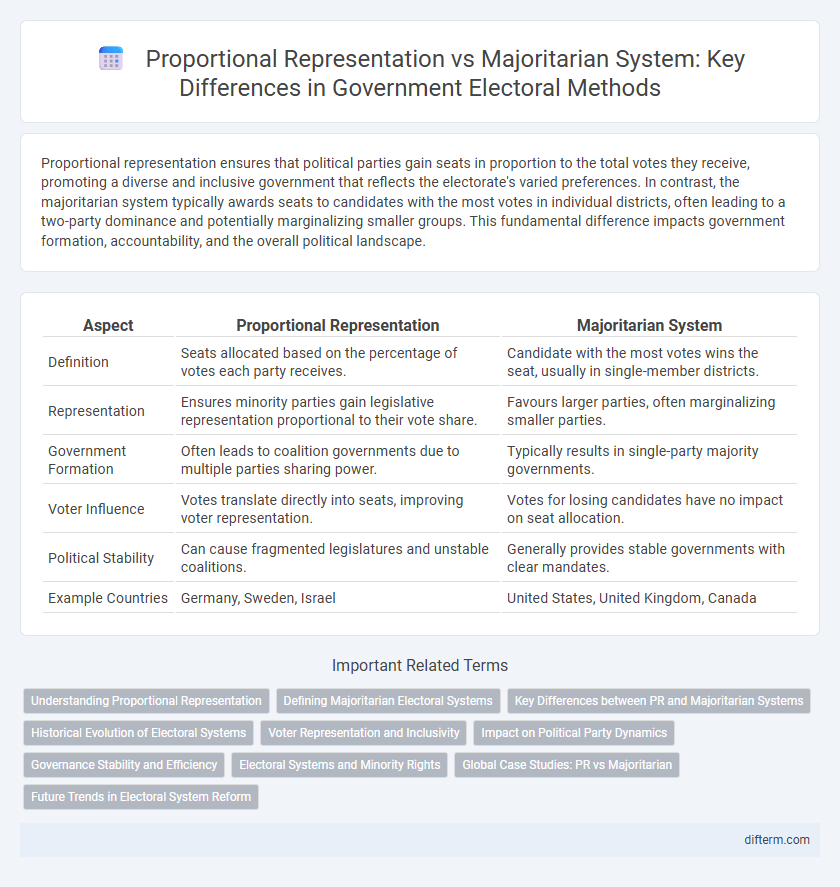Proportional representation ensures that political parties gain seats in proportion to the total votes they receive, promoting a diverse and inclusive government that reflects the electorate's varied preferences. In contrast, the majoritarian system typically awards seats to candidates with the most votes in individual districts, often leading to a two-party dominance and potentially marginalizing smaller groups. This fundamental difference impacts government formation, accountability, and the overall political landscape.
Table of Comparison
| Aspect | Proportional Representation | Majoritarian System |
|---|---|---|
| Definition | Seats allocated based on the percentage of votes each party receives. | Candidate with the most votes wins the seat, usually in single-member districts. |
| Representation | Ensures minority parties gain legislative representation proportional to their vote share. | Favours larger parties, often marginalizing smaller parties. |
| Government Formation | Often leads to coalition governments due to multiple parties sharing power. | Typically results in single-party majority governments. |
| Voter Influence | Votes translate directly into seats, improving voter representation. | Votes for losing candidates have no impact on seat allocation. |
| Political Stability | Can cause fragmented legislatures and unstable coalitions. | Generally provides stable governments with clear mandates. |
| Example Countries | Germany, Sweden, Israel | United States, United Kingdom, Canada |
Understanding Proportional Representation
Proportional representation allocates legislative seats based on the percentage of votes each party receives, ensuring a more accurate reflection of the electorate's preferences. This system promotes political diversity and minority representation by allowing smaller parties to gain seats proportional to their support. Compared to majoritarian systems, proportional representation reduces the likelihood of wasted votes and promotes coalition governments.
Defining Majoritarian Electoral Systems
Majoritarian electoral systems allocate legislative seats based on the candidate or party that secures the most votes in a given district, often resulting in single-winner outcomes. This system emphasizes clear, decisive victories and tends to favor larger parties, reducing fragmentation within the legislature. It contrasts with proportional representation, which distributes seats according to the overall vote share, aiming for a more precise reflection of voter preferences.
Key Differences between PR and Majoritarian Systems
Proportional representation (PR) systems allocate seats based on the percentage of votes each party receives, ensuring a broader reflection of voter preferences and often leading to multi-party legislatures. Majoritarian systems, such as first-past-the-post, award seats to candidates with the highest votes in single-member districts, typically resulting in single-party dominance and clearer majorities. PR systems promote inclusivity and coalition governments, while majoritarian systems emphasize stability and direct accountability.
Historical Evolution of Electoral Systems
Proportional representation systems emerged in the early 20th century as a response to the limitations of majoritarian systems, aiming to more accurately reflect the diversity of voter preferences within legislatures. Majoritarian systems, with origins tracing back to British common law, prioritize single-member districts and winner-takes-all outcomes, often marginalizing minority groups. Historical shifts towards proportional representation in countries like Germany and the Netherlands highlight the demand for inclusivity and fair representation amidst increasing political pluralism.
Voter Representation and Inclusivity
Proportional representation systems enhance voter representation by allocating seats based on the percentage of votes each party receives, ensuring minority voices gain legislative presence. Majoritarian systems often lead to winner-takes-all outcomes, which can marginalize smaller parties and reduce overall inclusivity. The proportional approach promotes a broader spectrum of political views, fostering a more inclusive and representative government.
Impact on Political Party Dynamics
Proportional representation fosters multi-party systems by allocating seats based on vote share, encouraging coalition-building and diverse political representation. Majoritarian systems typically favor larger parties, often leading to two-party dominance and more stable but less pluralistic governance. This dynamic shapes party strategies, voter choice, and legislative collaboration in parliamentary democracies.
Governance Stability and Efficiency
Proportional representation systems enhance governance stability by encouraging coalition governments that represent diverse political interests, reducing the risk of abrupt policy shifts. Majoritarian systems often yield single-party governments, enabling swift decision-making and efficient policy implementation but risking political polarization. Balancing inclusivity and decisiveness is critical for sustainable governance outcomes in both frameworks.
Electoral Systems and Minority Rights
Proportional representation electoral systems allocate legislative seats based on the percentage of votes each party receives, enhancing minority rights by ensuring diverse voices gain representation. Majoritarian systems grant seats to individual candidates who receive the most votes in their constituencies, often marginalizing smaller parties and minority groups. Empirical studies reveal that proportional systems promote political inclusion and policy responsiveness to minority interests more effectively than winner-takes-all approaches.
Global Case Studies: PR vs Majoritarian
Proportional representation systems in countries like Germany and New Zealand promote multi-party collaboration and accurately reflect diverse voter preferences, enhancing political stability and inclusion. Majoritarian systems exemplified by the United States and the United Kingdom often lead to two-party dominance, simplifying governance but potentially marginalizing minority groups. Global case studies reveal that proportional representation fosters broader representation, while majoritarian models prioritize decisiveness and constituency linkages.
Future Trends in Electoral System Reform
Future trends in electoral system reform emphasize a shift towards proportional representation to enhance political inclusivity and accurately reflect diverse voter preferences. Majoritarian systems, while promoting stability through clear winners, face increasing criticism for marginalizing minority voices and fostering polarization. Emerging reforms across democracies aim to balance representativeness and governability by integrating mixed electoral models and leveraging digital technologies for transparent vote counting.
proportional representation vs majoritarian system Infographic

 difterm.com
difterm.com